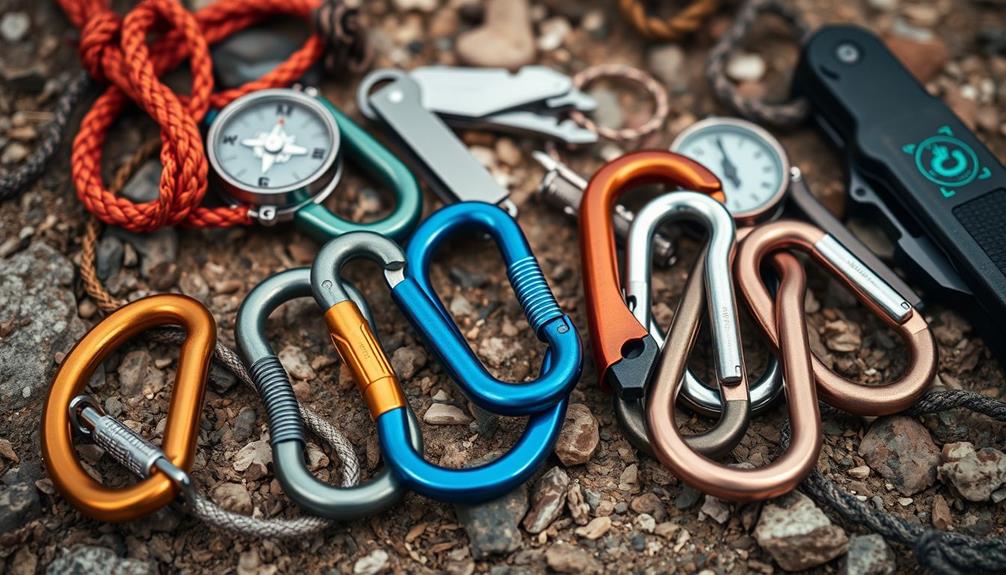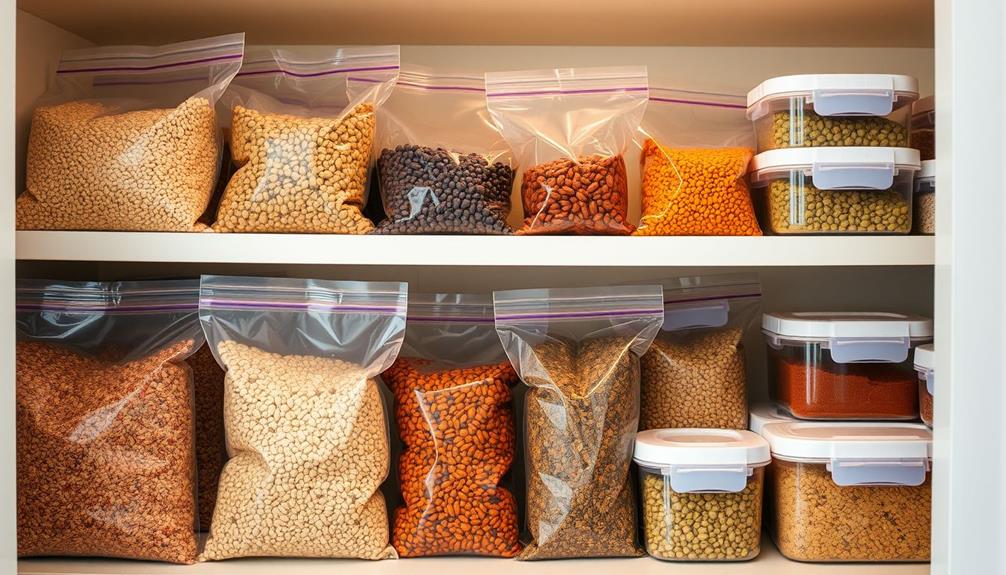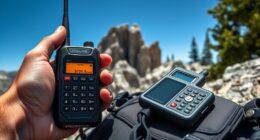Carabiners are essential for your survival gear, thanks to their versatility and reliability in emergencies. They come in various types, including locking and non-locking options, each serving different purposes. Pay attention to the material strength ratings, like 7075 aluminum or steel, to guarantee they can handle your load. You can use them to secure gear, organize essentials, or even for self-defense. Regular inspections and proper maintenance keep them safe and effective. Choosing high-quality brands guarantees you're prepared for any adventure. Discover more tips and tricks to optimize your carabiner use by exploring further.
Key Takeaways
- Choose locking carabiners for securing survival gear to prevent accidental openings during critical situations.
- Select durable materials like 7075 aluminum or steel with high MBS ratings for reliable strength in demanding conditions.
- Regularly inspect and maintain carabiners to ensure they remain free from wear, corrosion, or damage that could compromise safety.
- Consider versatile carabiners with built-in tools, such as bottle openers, to enhance functionality in survival scenarios.
- Prioritize reputable brands like Black Diamond or Petzl, which meet rigorous safety standards and performance expectations for outdoor gear.
Carabiner Types

When it comes to choosing carabiners, you'll want to sort through the various types available to find the ones that best suit your needs.
Locking carabiners are a must for safety, as they prevent accidental openings during emergencies. Non-locking carabiners offer quick access and work well for less critical tasks.
If you're looking for lightweight options, wiregate carabiners reduce weight without sacrificing strength, making them ideal for everyday carry. For added security, consider screwgate carabiners with a twist-lock mechanism.
Quickdraw carabiners are perfect for climbing, integrating a sling for ease of use. Some carabiners even come with built-in tools, enhancing functionality.
Assess your activities to choose the right type that meets your specific requirements.
Material Strength Ratings

Material strength ratings are essential for guaranteeing the safety and reliability of your carabiners.
When selecting a carabiner, consider the following key factors that influence material strength:
- MBS (Minimum Breaking Strength): This indicates the maximum load your carabiner can handle before failure. Always check this rating to guarantee it meets your needs.
- Material Type: 7075 aluminum is lightweight and strong, while steel offers higher strength for heavy loads. Select the right material based on your intended use.
- UIAA Standards: Look for carabiners that meet international climbing standards, guaranteeing they've been rigorously tested for safety and reliability.
Functional Uses

Understanding material strength ratings helps you choose the right carabiner, but knowing how to use it effectively is just as important.
Carabiners serve various functional uses that can enhance your outdoor experience and survival preparedness. You can secure gear, attach equipment, or organize keys for quick access. Larger carabiners can even function as self-defense tools in emergencies.
Their lightweight design makes carrying hassle-free, while versatile designs streamline tasks like securing items to your backpack. You'll find them invaluable for hiking, camping, and in bug-out bags.
Some carabiners even include built-in tools, like bottle openers or screwdrivers, adding to their utility. Embrace the multi-functional nature of carabiners to maximize their benefits in your everyday adventures.
Selection Criteria

Selecting the right carabiner can make a significant difference in your outdoor adventures and survival preparations.
You'll want to focus on a few key criteria to guarantee you get the best fit for your needs:
- Weight Ratings: Always check the maximum load capacity to avoid accidents during critical moments.
- Material: Look for durable, rust-resistant materials like 7075 aluminum or steel to withstand tough conditions.
- Carabiner Features: Evaluate the locking mechanisms and size; a locking carabiner offers extra safety, while non-locking options provide quick access.
Maintenance Tips

Regular maintenance of your carabiners is essential for ensuring their reliability and longevity.
Start by inspecting them regularly for any signs of wear, corrosion, or damage. If you notice any issues, it's best to replace the carabiner to avoid potential failures.
Clean your carabiners using mild soap and water; avoid harsh chemicals that could degrade the material. For those with moving parts, apply silicone spray to keep them operating smoothly.
Store your carabiners in a dry, cool place to prevent moisture and rust buildup.
Ultimately, always keep an eye on their performance, and replace any that show excessive wear. Taking these steps will help maintain their functionality and extend their lifespan in your survival gear.
Safety Considerations

When it comes to using carabiners in your survival gear, safety is paramount. You should always choose the right type for your needs and understand its limits. Carabiners are versatile tools that can be used for various tasks such as securing gear, building makeshift shelters, and even for emergency rescue situations. They are considered everyday adventure essentials and can be found in many survival kits and outdoor gear collections. When selecting a carabiner, make sure to choose one that is rated for the weight and pressure you will be putting on it, and always check for any signs of wear or damage before each use. It’s also important to consider the material and design of the carabiner, as different styles and shapes may be better suited for specific tasks. Additionally, carabiners have become essential car escape tools, as they can be used to break windows or cut through seatbelts in emergency situations. Keeping a carabiner within reach in your vehicle can provide an extra level of safety and preparedness in unexpected circumstances. Always stay informed on the proper use and maintenance of your carabiners to ensure they remain reliable and safe for any adventure or emergency.
Here are three key safety considerations to keep in mind:
- Load Limits: Always check the Minimum Breaking Strength (MBS) rating. Exceeding this limit can lead to failure, risking your safety.
- Locking Mechanisms: Opt for locking carabiners when securing gear in critical situations. They prevent accidental openings.
- Regular Inspections: Frequently inspect your carabiners for signs of wear, corrosion, or damage. Replace any compromised ones immediately.
Recommended Brands

For those looking to invest in reliable carabiners, several brands stand out due to their quality and performance. Here's a quick overview of some top options to evaluate:
| Brand | Key Features | Typical Use |
|---|---|---|
| Black Diamond | High strength, durable | Climbing, hiking |
| Petzl | Innovative designs, lightweight | Caving, mountaineering |
| Omega Pacific | Military-grade strength | Heavy-duty applications |
These brands consistently deliver reliable products that meet rigorous safety standards. When choosing, keep in mind your specific needs—whether for climbing, camping, or everyday carry. Investing in a quality carabiner from one of these brands guarantees you're prepared for any adventure.
Frequently Asked Questions
Can I Use a Carabiner for Climbing Safety?
Yes, you can use a carabiner for climbing safety. Just make certain you choose a locking carabiner, as they provide secure closure and prevent accidental openings, which is vital for your safety during climbs.
How Do I Choose the Right Size Carabiner?
When choosing the right size carabiner, consider your gear's weight and purpose. Confirm it fits comfortably in your hand and securely attaches to your equipment, prioritizing safety and ease of use during activities.
Are Plastic Carabiners Safe for Outdoor Use?
When it comes to outdoor adventures, plastic carabiners might seem like lightweight champions, but they lack the strength needed for heavy-duty tasks. Stick to metal options for safety and reliability in challenging conditions.
Is It Safe to Use a Carabiner for Self-Defense?
Using a carabiner for self-defense can be effective, but it depends on the situation. Confirm it's sturdy and securely attached. Remember, it's not a primary weapon, so always prioritize personal safety and awareness.
What Are the Environmental Impacts of Carabiners?
Carabiners can impact the environment through material sourcing and disposal. You should choose durable, recyclable options to minimize waste and consider their lifecycle, ensuring responsible usage and proper disposal after their functional life ends.
Conclusion
So, as you gear up for your next adventure, remember that these simple clips can be the difference between a smooth journey and a total disaster. It's ironic how something so small can carry such weight in your survival toolkit. Choosing the right carabiner isn't just a matter of convenience; it's about ensuring your safety and preparedness. Embrace the irony of relying on a humble clip to tackle the wildest challenges, and let it empower your adventures.










